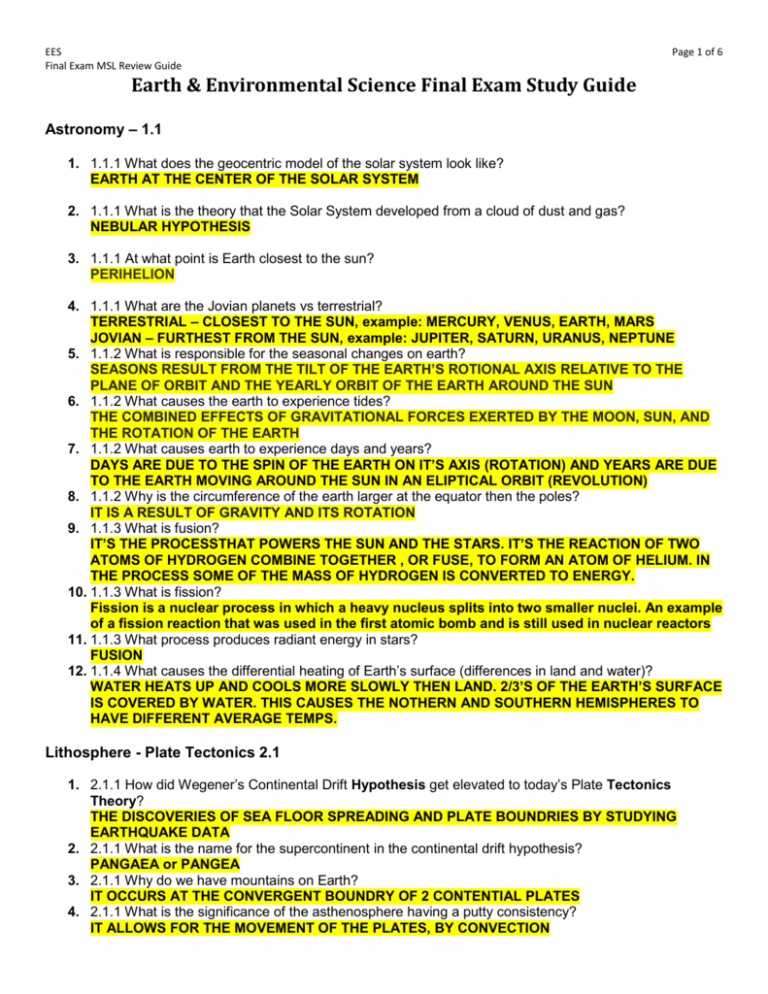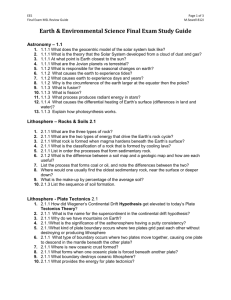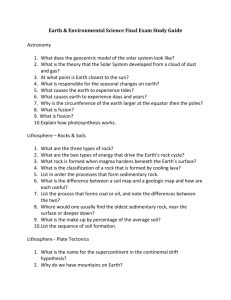Earth & Environmental Science Final Exam Study Guide
advertisement

EES Final Exam MSL Review Guide Page 1 of 6 Earth & Environmental Science Final Exam Study Guide Astronomy – 1.1 1. 1.1.1 What does the geocentric model of the solar system look like? EARTH AT THE CENTER OF THE SOLAR SYSTEM 2. 1.1.1 What is the theory that the Solar System developed from a cloud of dust and gas? NEBULAR HYPOTHESIS 3. 1.1.1 At what point is Earth closest to the sun? PERIHELION 4. 1.1.1 What are the Jovian planets vs terrestrial? TERRESTRIAL – CLOSEST TO THE SUN, example: MERCURY, VENUS, EARTH, MARS JOVIAN – FURTHEST FROM THE SUN, example: JUPITER, SATURN, URANUS, NEPTUNE 5. 1.1.2 What is responsible for the seasonal changes on earth? SEASONS RESULT FROM THE TILT OF THE EARTH’S ROTIONAL AXIS RELATIVE TO THE PLANE OF ORBIT AND THE YEARLY ORBIT OF THE EARTH AROUND THE SUN 6. 1.1.2 What causes the earth to experience tides? THE COMBINED EFFECTS OF GRAVITATIONAL FORCES EXERTED BY THE MOON, SUN, AND THE ROTATION OF THE EARTH 7. 1.1.2 What causes earth to experience days and years? DAYS ARE DUE TO THE SPIN OF THE EARTH ON IT’S AXIS (ROTATION) AND YEARS ARE DUE TO THE EARTH MOVING AROUND THE SUN IN AN ELIPTICAL ORBIT (REVOLUTION) 8. 1.1.2 Why is the circumference of the earth larger at the equator then the poles? IT IS A RESULT OF GRAVITY AND ITS ROTATION 9. 1.1.3 What is fusion? IT’S THE PROCESSTHAT POWERS THE SUN AND THE STARS. IT’S THE REACTION OF TWO ATOMS OF HYDROGEN COMBINE TOGETHER , OR FUSE, TO FORM AN ATOM OF HELIUM. IN THE PROCESS SOME OF THE MASS OF HYDROGEN IS CONVERTED TO ENERGY. 10. 1.1.3 What is fission? Fission is a nuclear process in which a heavy nucleus splits into two smaller nuclei. An example of a fission reaction that was used in the first atomic bomb and is still used in nuclear reactors 11. 1.1.3 What process produces radiant energy in stars? FUSION 12. 1.1.4 What causes the differential heating of Earth’s surface (differences in land and water)? WATER HEATS UP AND COOLS MORE SLOWLY THEN LAND. 2/3’S OF THE EARTH’S SURFACE IS COVERED BY WATER. THIS CAUSES THE NOTHERN AND SOUTHERN HEMISPHERES TO HAVE DIFFERENT AVERAGE TEMPS. Lithosphere - Plate Tectonics 2.1 1. 2.1.1 How did Wegener’s Continental Drift Hypothesis get elevated to today’s Plate Tectonics Theory? THE DISCOVERIES OF SEA FLOOR SPREADING AND PLATE BOUNDRIES BY STUDYING EARTHQUAKE DATA 2. 2.1.1 What is the name for the supercontinent in the continental drift hypothesis? PANGAEA or PANGEA 3. 2.1.1 Why do we have mountains on Earth? IT OCCURS AT THE CONVERGENT BOUNDRY OF 2 CONTENTIAL PLATES 4. 2.1.1 What is the significance of the asthenosphere having a putty consistency? IT ALLOWS FOR THE MOVEMENT OF THE PLATES, BY CONVECTION EES Final Exam MSL Review Guide Page 2 of 6 5. 2.1.1 What kind of plate boundary occurs where two plates grind past each other without destroying or producing lithosphere TRANSFORM FAULT BOUNDRY 6. 2.1.1 What type of boundary occurs where two plates move together, causing one plate to descend in the mantle beneath the other plate? CONVERGENT BOUNDRY 7. 2.1.1 Where is new oceanic crust formed? DIVERGENT BOUNDRY – MID OCEANIC RIDGE 8. 2.1.1 What forms when one oceanic plate is forced beneath another plate? SUBDUCTION or OCEANIC TRENCH 9. 2.1.1 What boundary destroys oceanic lithosphere? CONVERGENT BOUNDRY 10. 2.1.1 What provides the energy for plate tectonics? CONVECTION CURRENTS OF THE MANTLE 11. The Hawaiian Islands were formed when the Pacific Plate moved over what unique feature? HOT SPOT 12. What layers of Earth make up the lithosphere? THE CRUST AND THE UPPER MANTLE Lithosphere – Earthquakes 1. What are earthquakes usually associated with? MOVEMENT OF THE PLATES AT FAULTS (or just FAULTS) 2. What is a travel time graph be used for? TO FIND THE DISTANCE FROM THE EPICENTER OF AN EARTHQUAKE 3. What instrument records earthquake waves? SEISMOMETERS 4. Where is the epicenter of an earthquake versus the focus? THE EPICENTER IS THE EXACT LOCATION ON THE EARTH’S SURFACE DIRECTLY ABOVE THE FOCUS OF AN EARTHQUAKE 5. Name the smaller earthquakes that can precede the actual earthquake versus those that come after. FORE SHOCK PRECEDE AN EATHQUAKE AND AFTER SHOCK FOLLOWS AN EARTHQUAKE 6. Why do earthquakes often cause damaging fires? DESTRUCTION OF GAS AND POWER LINES 7. What causes a tsunami? IT IS THE SHOCK WAVE DUE TO AN UNDERWATER EARTHQUAKE OR LANDSLIDE 8. What is the amount of shaking caused by an earthquake at a given location? INTENSITY 9. What is a fault? A BREAK IN THE ROCKS THAT MAKE UP THE EARTH’S CRUST, ALONG WHICH ROCKS EITHER SLIDE OR MOVE PAST EACH OTHER 10. Which seismic waves are the most destructive? Surface waves, which cause the surface to rise and fall, are particularly destructive when traveling through loose earth. When P and S reach the earth’s surface, their energy can be converted into surface wave 11. What is the minimum number of seismic stations needed to determine the location of an epicenter? 3 12. What is the earthquakes source called? FOCUS 13. What is the scale most widely used by scientist to measure earthquakes? Moment magnitude is the most widely used measurement for earthquakes because it is the only magnitude scale that estimates the energy released by earthquakes EES Final Exam MSL Review Guide Page 3 of 6 14. What seismic waves travel the fastest? Slowest? P (PRIMARY) WAVES FASTEST, S (SECONDARY) WAVES 2ND FASTEST, SURFACE WAVES SLOWEST Lithosphere – Volcanoes 1. What is a caldera? a large crater in a volcano, caused by a major eruption followed by the collapse of the volcanic pipe walls that form the volcano's cone. It may later contain a lake. 2. What is lahar? a landslide or mudflow of volcanic debris, especially after a heavy rainfall 3. How does a volcanic eruption affect the atmosphere? VOLCAIC ERUPTIONS INJECT ASH AND AEROSOL CLOUDS INTO THE ATMOSPHERE AND PRODUCE MORE THEN 100 MILLION TONS OF CO2 EACH YEAR 4. What are the particles of rock, lava, ash & other volcanic fragments blown from the vent of a volcano? PYROCLASTIC MATERIALS Hydrosphere – Surface and Ground Fresh Water 1. What is the difference between the floodplain, meander, delta, and what ecosystem services do each provide? Ecosystem services is defined as benefits people obtain from ecosystems floodplain is the flat, low-lying portion of a stream valley subject to periodic flooding - Ecosystem services - •Reduces flood velocities •Stabilizes soils •Improves water quality •Provide habitat for plants and animals •Moderates water temperature •Recharge areas for groundwater A stream in a broad, flat-bottomed valley that is near its base level often develops a course with many bends called meanders. Ecosystem services – they slow down river flow Deltas are an accumulation of sediment formed where a stream enters a lake or ocean. Ecosystem services – hurricane and flood protection, water supply, water quality, recreation and fisheries. 2. What is a drainage basin (i.e., watershed) and why is it important to know the boundaries around one? It is an extent or an area of land where surface water from rain, melting snow, or ice converges to a single point at a lower elevation, usually the exit of the basin, where the waters join another water body, such as a river, lake, reservoir, estuary, wetland, sea, or ocean. 3. What zone is groundwater found in underground? WATER TABLE or ZONE OF SATURATION 4. What are the permeable rock layers or sediments that transmit groundwater freely? AQUIFER 5. Why do we have water shortages? OVER USE AND CONTAMINATION EES Final Exam MSL Review Guide Page 4 of 6 6. What are the laws that protect our water supply? Clean Water Act (CWA) aka Federal Water Pollution Control Act Amendments of 1972, also Clean Water Act of 1977[3] and the Water Quality Act of 1987. 7. What types of events can pollute groundwater today? Landfills, leaky sewer lines, pipelines, underground storage tanks, wells: poorly constructed or abandoned, septic systems, INDUSTRAL ACTIVITY 8. What types of events pollute our surface water today? Air pollution, salt for de-icing streets, chemicals: storage & spills, mining activities, fertilizers, livestock waste storage facilities & landspreading, pesticides Hydrosphere – Oceanography 1. Approximately how much of Earth’s surface is covered by land versus water? 71% WATER 29% LAND 2. How does the presence of ocean versus land affect the temperature of Earth’s Hemispheres? THE SOUTHERN HEMISPHERE IS WARMER AND HAS MORE STABLE TEMP RANGE BE CAUSE THERE IS MORE WATER. LAND HEATS AND COOLS FASTER THEN WATER 3. Where does seafloor spreading occur? MID OCEANIC RIDGES 4. What process uses light energy to convert water & carbon dioxide into energy-rich, glucose molecules? PHOTOSYNTHESIS: CO2 + H2O + LIGHT → C6H12O6 + O2 5. What is the complex feeding relationship among a number of different organisms? FOOD WEB 6. List at least 3 reasons why we have beach erosion in North Carolina. WINDS, RISING SEA LEVELS AND STRONG STORMS Atmosphere - Weather and Climate 2.5 1. What is the form of oxygen that combines three oxygen atoms into each molecule? OZONE 2. What are isobars? What happens when they are close together? Far apart? ISOBARS—lines on a map that connect places of equal air pressure. — Closely spaced isobars indicate a steep pressure gradient and high winds. Widely spaced isobars indicate a weak pressure gradient and light winds 3. Where is air pressure exerted and how does it change as you move up through Earth’s atmosphere? IT IS THE WEIGHT OF ALL THE AIR ABOVE YOU AND IS EXERTED IN ALL DIRECTIONS EQUALLY. IT DECREASES IN PRESSURE AS YOU INCREASE IN ALTITUDE 4. What are isotherms? lines on a map that connect places of equal temperature EES Final Exam MSL Review Guide Page 5 of 6 5. What is the ratio of air’s water vapor content to its capacity to hold water vapor at the same temperature? RELATIVE HUMIDITY 6. What are maritime air masses versus continental? MARITIME AIR MASSES ARE MOIST AND FORM OVER WATER WHILE CONTENTIAL ARE DRY AND FORM OVER LAND 7. What is the boundary that separates different air masses? A FRONT 8. Which type of front is shown by a line with triangular points versus semicircles on one side? TRIANGLES SHOW A COLD FRONT AND THE SEMICIRCLES INDICATE A WARM FRONT 9. How do you decide which side to put the semicircles or triangles? THEY ON THE SIDE OF THE LINE TO INDICATE DIRECTION OF TRAVEL…IF ON THE EAST SIDE OF THE LINE THE FRONT IS MOVING EAST 10. When you see a wind flag, how does it help you determine the direction of the wind and how is this direction labeled? WIND FLAGS POINT IN THE DIRECTION THAT A WIND BLOWS AND THE WIND IS LABLED THE SAME WAY – A NORTHEASTERN WIND BLOWS TO THAT DIRECTION 11. Why are we concerned about climate change today when we have had climate changes in the past? THE CURRENT TREND IN CHANGE IS CREATING DANGEROUS SEA LEVEL RISE AND DEADLY WEATHER PATTERS THAT TOGETHER CAUSE ECONOMIC AND PHYSICAL DANGER TO ALL PARTS OF THE BIOME 12. In what layer of our atmosphere do we find rainbows and why? RAINBOWS ARE IN THE TROPOSPHERE. THEY ARE CREATED BY REFRACTION OF LIGHT THROUGH RAIN DROPS. ALL WEATHER PATTERNS ONLY OCCUR IN THE TROPOSPHERE. Natural Resources & Global Issues 2.6-2.8 1. What are some examples of renewable resources? (give a minimum of three) WIND, SOLAR, HYRDROELECTRIC, GEOTHERMAL, TIDAL 2. What defines a renewable resource? A RESOURCE WHICH IS REPLACED NATURALLY AND CAN BE USED AGAIN AND AGAIN 3. What are some examples of nonrenewable resources? COAL, URANIUM, GAS, IRON 4. What type of energy resource could replace the dwindling petroleum supplies? WIND, SOLAR, HYRDROELECTRIC, GEOTHERMAL, TIDAL 5. What are the advantages of solar energy? NONPOLLUTING, LONG TERM FINICIAL SAVINGS, CLIMATE STABILITY 6. What is the fuel source in nuclear reactors? URANIUM 7. How does nuclear fission produce energy? Fission is a nuclear process in which a heavy nucleus splits into two smaller nuclei. THIS CAUSES A RELEASE OF ENERGY. IT IS STILL USED IN NUCLEAR REACTORS. 8. What produces hydroelectric power? THE FORCE OF GRAVITY, AS WATERFALLS IT IS PASSED OVER A TURBINE THAT SPINS A GENERATOR THAT PRODUCES ELECTRICITY 9. What are some examples of non-point source pollution for fresh water? Nonpoint source (NPS) pollution, unlike pollution from industrial and sewage treatment plants, comes from many diffuse sources. NPS pollution is caused by rainfall or snowmelt moving over and through the ground. As the runoff moves, it picks up and carries away natural and humanmade pollutants, finally depositing them into lakes, rivers, wetlands, coastal waters, and even our underground sources of drinking water. 10. What amount of Earth’s total water supply is usable fresh water? AROUND 0.62% OF THE TOTAL WATER ON THE PLANET 11. What is the function of the atmosphere’s ozone layer and where is it found? BLOCK UV RADIATION AND IS IN THE STARTOSPHERE EES Final Exam MSL Review Guide Page 6 of 6 12. What does the greenhouse gas carbon dioxide help the atmosphere do? MAINTAIN AVERAGE TEMP. 13. How might U.S. consumption and consumerism play a role in poverty or lack of equity in other countries? WE ARE USING THE OTHER COUNTRIES AS A CHEAP RESOURCE FOR THINGS WE DO NOT HAVE OR CAN NOT PRODUCE CHEAPLY. WE ARE PROFITING FROM CHEAP LABOR 14. Know the pros and cons of obtaining energy from various sources such as Natural Gas, Coal, Nuclear, Solar, Wind, or Hydroelectric, Oil, biomass, etc. __________________________________________________________________________________ __________________________________________________________________________________ 15. How might we meet our energy needs of the future? ALTERNATIVE FUELS AND RENEWABLE RESOURCES 16. What does a sustainable future mean? A FUTURE WHERE WE DO NOT EXHAUST ALL OF OUR RESOURCES AND MAINTAIN OUR STANDARD OF LIVING AND INCREASE IT FOR ALL PEOPLE ON EARTH






